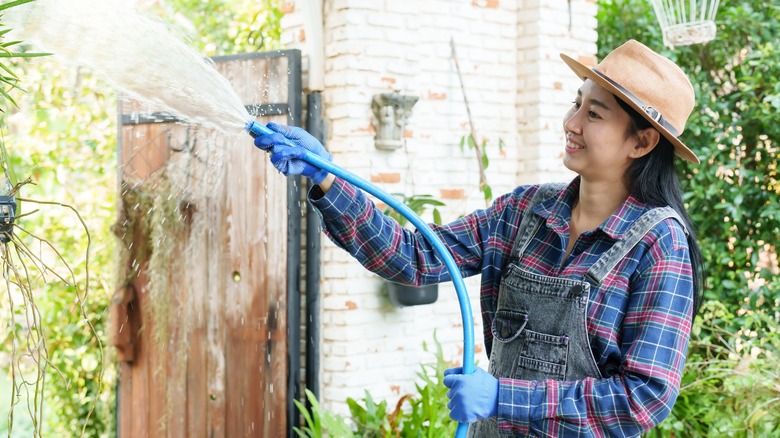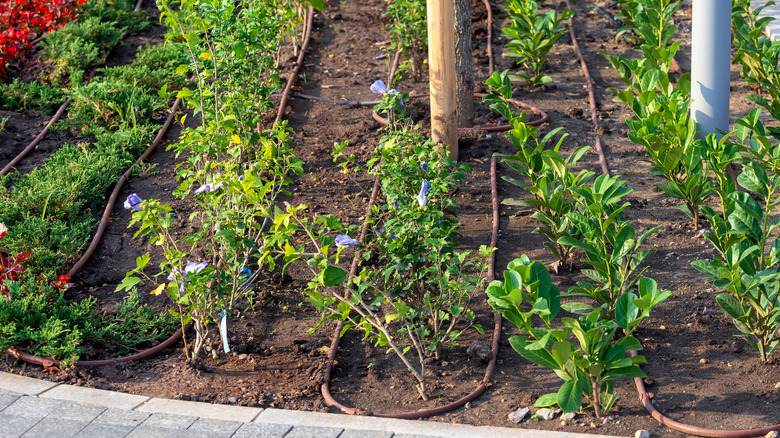Easily Water Your Lawn And Garden With This Clever Hose Hack
We may receive a commission on purchases made from links.
Did you know you can't recycle garden hoses? They tangle easily, creating knots that muck up the sorting system at the recycling plant. Thankfully, there's a good reason to keep a retired hosepipe. If you're looking for budget-friendly DIY home garden watering systems, you can't get much cheaper than punching a few holes into a hose. Soaker hose activated! Okay, so you might have to buy a few inexpensive hose fixtures, too, and dedicate a decent amount of time to planning your irrigation layout, the DIY task itself, and set up. But let's be real here ... Can you really call yourself a passionate backyard gardener if all that doesn't sound appealing? Plus, you can expect a ready-made drip irrigation system to set you back anywhere between $500 and $3,000 on average. This DIY is basically free!
Aside from the fact that installing a soaker hose could save you thousands, why bother taking the time out of your probably already very busy gardening to-do schedule to undertake this up-cycle? Well, this specific type of irrigation system has tons of benefits for your garden. The water drips from the holes in the hose slowly. Position said holes right next to your plants' stems, and you can be sure it's reaching their thirsty roots instead of evaporating away. And since you lay soaker hoses throughout your garden, they're always out and ready to work. All you need to do is turn on a tap.
Plan your irrigation before attacking your hose with a drill
Draw a birds-eye representation of your garden on paper or electronically and mark the areas you wish to irrigate, right down to the specific plants or crop rows. From there, you can map out important factors like how far your old hose will stretch and where to punch the holes. Include your water source on your plan. If the irrigation system is fed by your municipal water supply or a well with good water pressure, you can have a longer hose. If the water is gravity-fed from a rain barrel or you have poor pressure, a shorter hose is better. It's also not all a bed of dew drops.
Any old hose will do for this DIY, though there's some evidence that PVC and even rubber hoses leach contaminants into the water that runs through them — thus, into your garden, too. If you're concerned about harmful chemicals, do this project with a food-grade polyurethane hose. You can, of course, buy a new hose. Pay under $10 for a 25-foot Expert Gardener light-duty hose from Walmart. You'll also need something to punch or cut holes in the garden hose — an electric drill, a nail and hammer, an awl, or tin snips all work just fine — and something to close one end of the hose — an end cap, duct tape, wire, or cable ties. If your hose doesn't already have one, get a coupling to fit it to the outdoor faucet.
How to transform an old garden hose into a soaker hose
Ready to repurpose your old hose and use it in your garden? Attach an end cap or bend one end of the hose over onto itself and secure the loop tightly with the duct tape, wire, or cable ties. Run the hose through the garden and mark the emitter hole locations with a permanent marker, then drill or otherwise create them. Commercial soaker hoses clog easily, and the holes can close when the hose material expands in hot weather. You might not notice the failure for a while, especially if the hose is buried in the ground. Make your holes at least a quarter of an inch wide to avoid this issue. Attach your hose using the coupling, and turn the water on incrementally until you reach the right flow level. The holes should emit dribbles, not jets, of water.
One neat idea from YouTuber Growing a Backyard Grocery Store is to connect one end of your new-to-you soaker hose to a Driver's Choice auto funnel from Dollar Tree. Affix the funnel, cone side up, to an outside corner of your greenhouse. Whenever it rains, the water will collect in the funnel and run down the hose, watering the plants inside. This would also work for covered patio or balcony gardens. Other optional extras include a timer, menders (if you need to join two hoses together), and next-level features like a back-flow preventer, hose filter, or pressure regulator.

